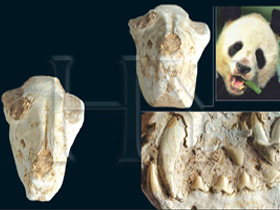
As can be seen here, the bone that protrudes from the panda's wrist is not really a bone at all, but a support making it easier for the animal to cling onto bamboo stalks.
One of the classic evolutionist arguments is that of the Panda's thumb, made famous by Stephen Jay Gould. Along with its five fingers, the panda also has a bony protrusion on its wrist known as the radial sesamoid bone.
In evolutionists' view, the panda-originally a carnivore like dogs and cats-began feeding on bamboo. According to the evolutionist scenario, the sixth finger emerged so that the panda could grasp bamboo more easily. A different evolutionist claim is that though this sixth finger is not perfect, it's as good as natural selection could make it. But in fact, these are claims made entirely in line with evolutionist preconceptions, devoid of proof and explain nothing.
Evolutionists include the panda among the carnivores because it has wide jaws, teeth and strong claws. They claim that the panda's alleged ancestors used these features against other animals. Yet the panda's only enemy is man; among other animals, it has no enemies. Its powerful teeth and jaws are for breaking off and chewing bamboo stems. Its strong claws serve for climbing up bamboo stems. Therefore, there is not the slightest evidence that pandas-which generally eat bamboo and fruit and other plants from time to time-evolved from carnivorous forerunners.
Evolutionists have been unable to agree on which animal the panda might have evolved from. Some evolutionists place the panda in the same category as bears; others in the same category as raccoons, because no findings suggest that these animals have evolved from any other class. Evolutionists speculate on the basis of similarities alone, and disagree with one another because their conjectures are sheer fantasy.
 Evolutionists look for disharmony or flaws in nature, in their efforts to find evidence for denying Allah's flawless creation. As with the subject of the panda's "thumb," however, these efforts have always been in vain. |
In fact, this sixth finger is a kind of bone known as the radial sesamoid bone, which generally facilitates movement at the joints and prevents the tendons from tearing. This structure, emerging from the wrist, is actually no finger at all, but a support that helps the other fingers grip onto bamboo stalks.174
Evolutionists maintain that this bone developed in place of a finger, but does not serve as one-saying, for example, that it cannot strip shoots. However, they also say that it is sufficiently developed for grasping. That is in any case the job of this sixth finger, and the panda has enough other fingers to perform other tasks perfectly.175 The idea that this structure's ideal shape would be that of a complete finger is a groundless, based on evolutionist prejudices. The bone is perfectly suitable in its present state.
One study published in Nature magazine in 1999 shows that in the panda's natural habitat, its thumb is highly efficient. The study, carried out by four Japanese researchers and performed using computerized tomography and magnetic resonance imaging, concluded that the panda's thumb is "one of the most extraordinary manipulation systems in mammalia."176
Evolutionists look for incompatibility or flaws in nature only to find evidence for denying Allah's immaculate creation. Yet these efforts have always proved fruitless. The panda's thumb is yet another instance of this.
174. Paul J. Morris, and Susan F. Morris, "The Panda's Thumb," Jan 2000 http://www.athro.com/evo/pthumb.html.
175. "The Panda's Thumb . . . No Evidence For Evolution" http://www.users.bigpond.com/rdoolan/panda.html.
176. Endo, H., Yamagiwa, D., Hayashi, Y. H., Koie, H., Yamaya, Y., and Kimura, J., "Role of the giant panda's ‘pseudo-thumb'", Nature, Vol. 397, 1999, p. 309.


